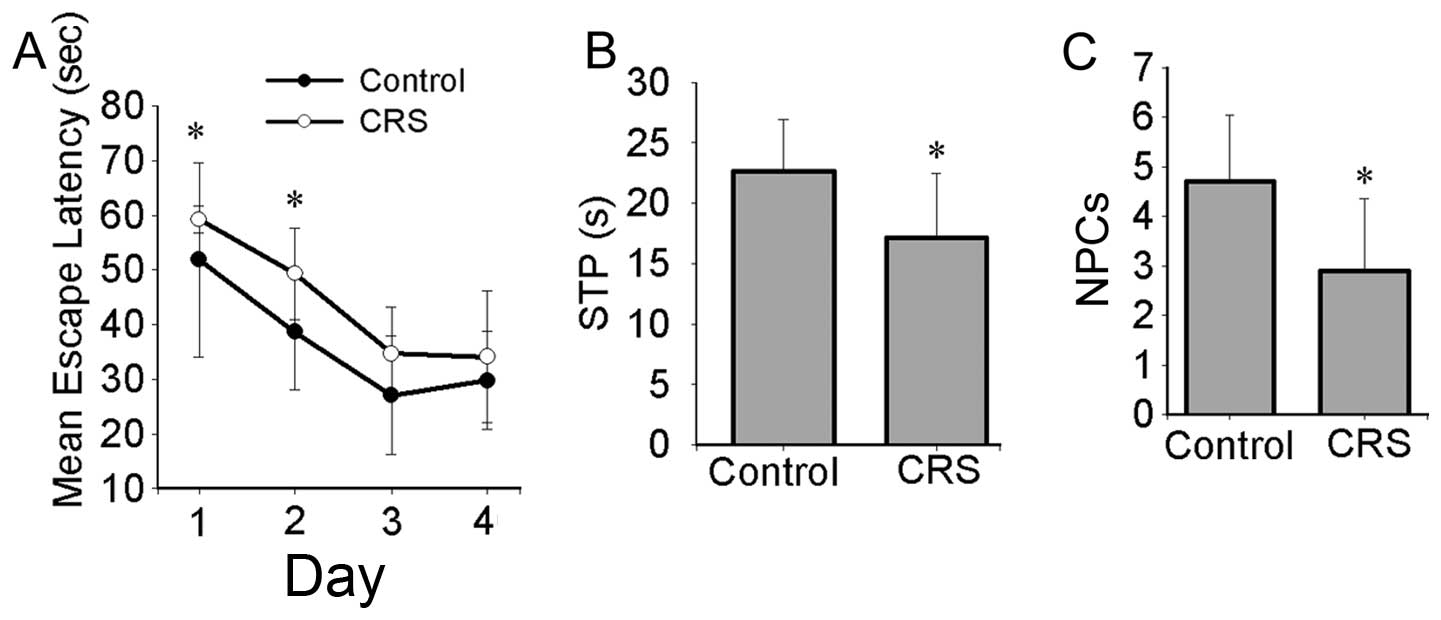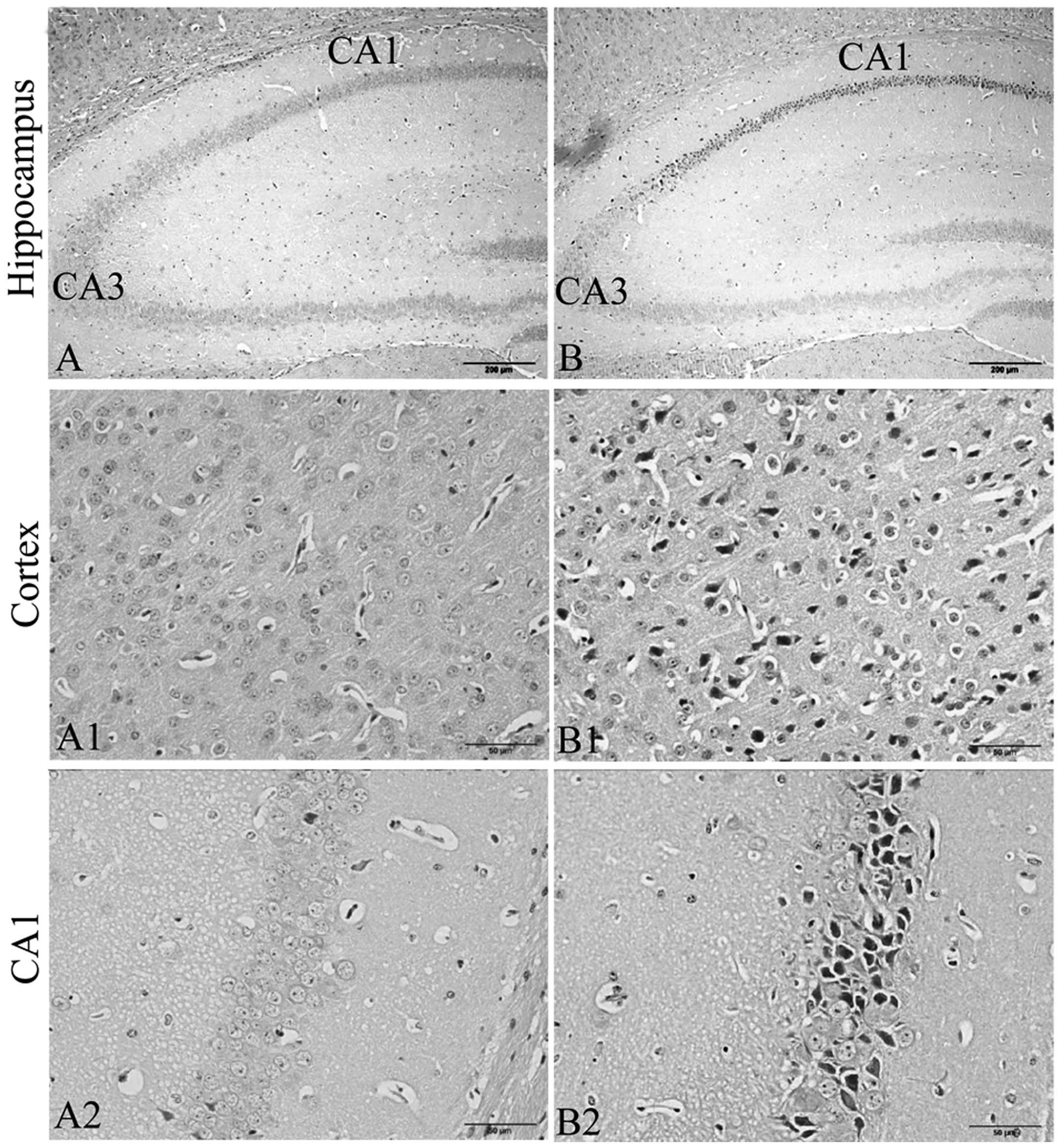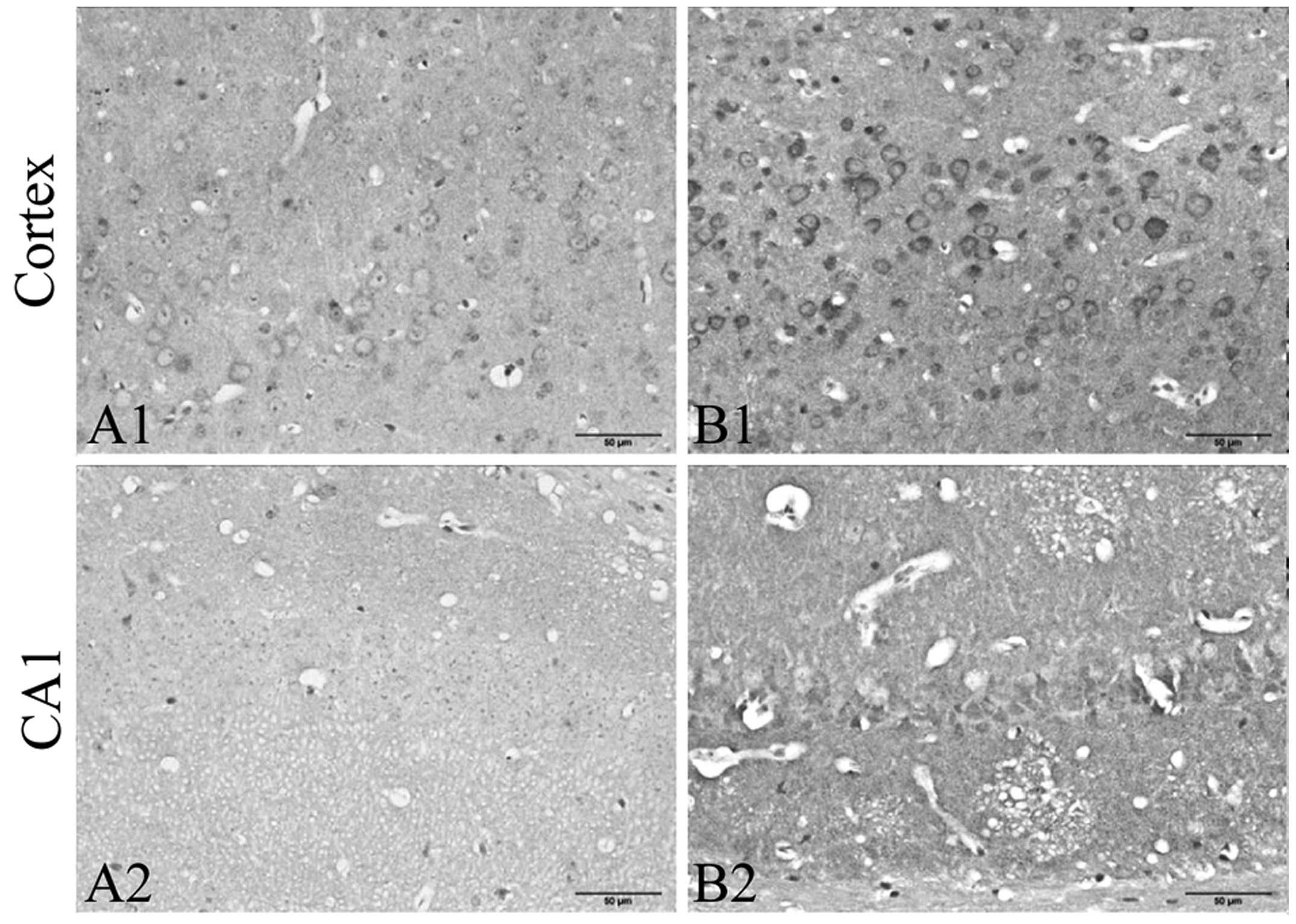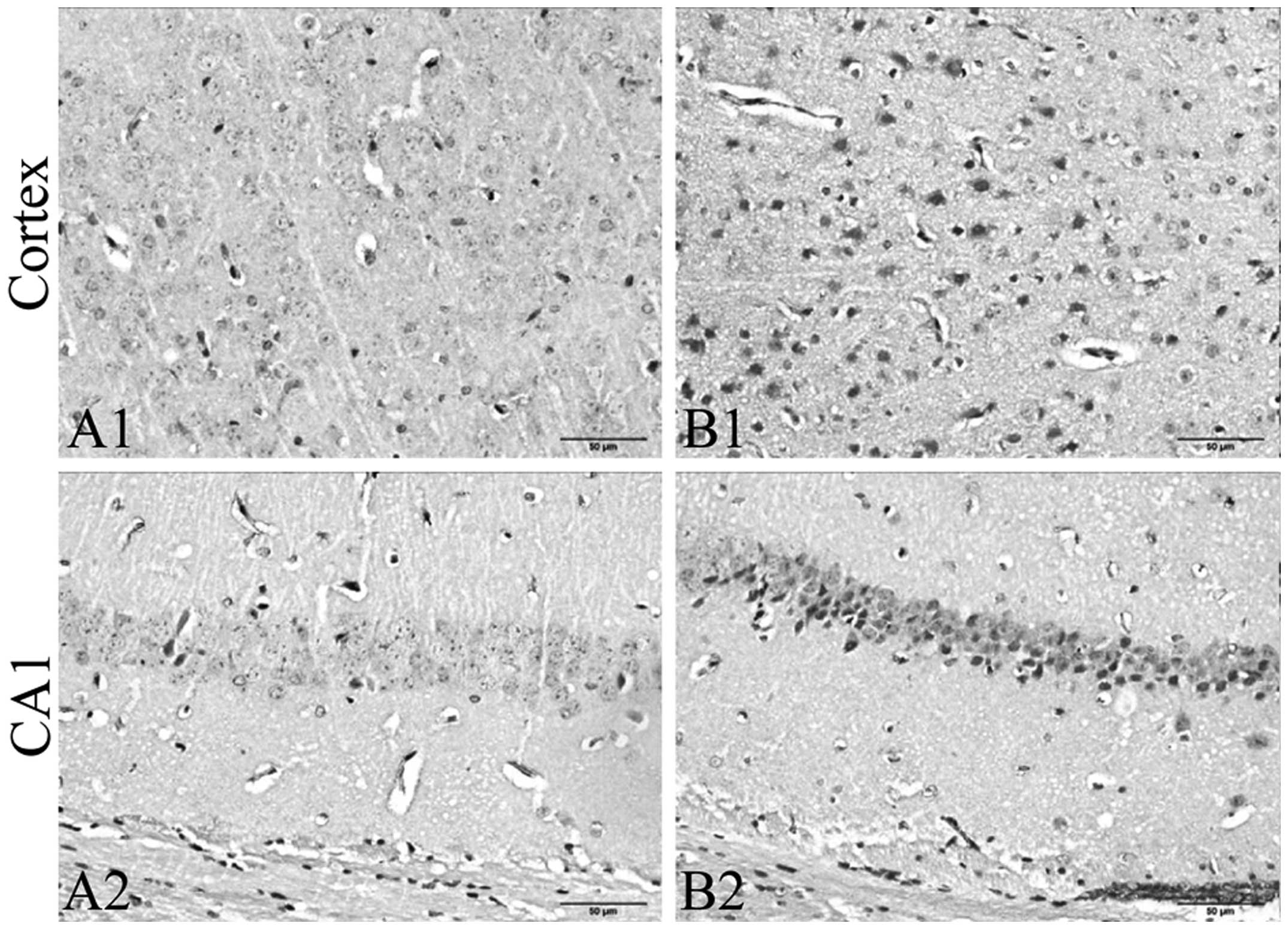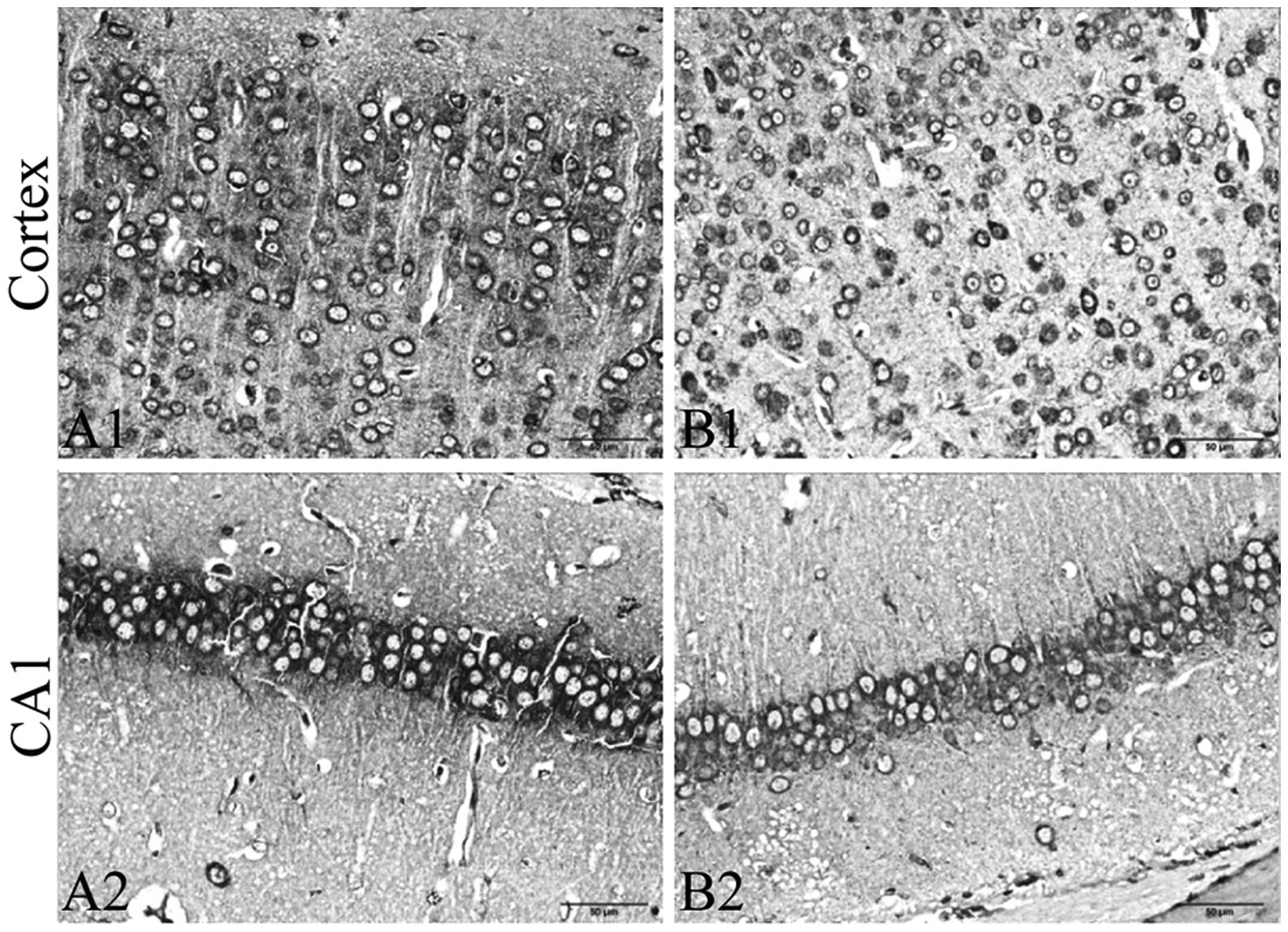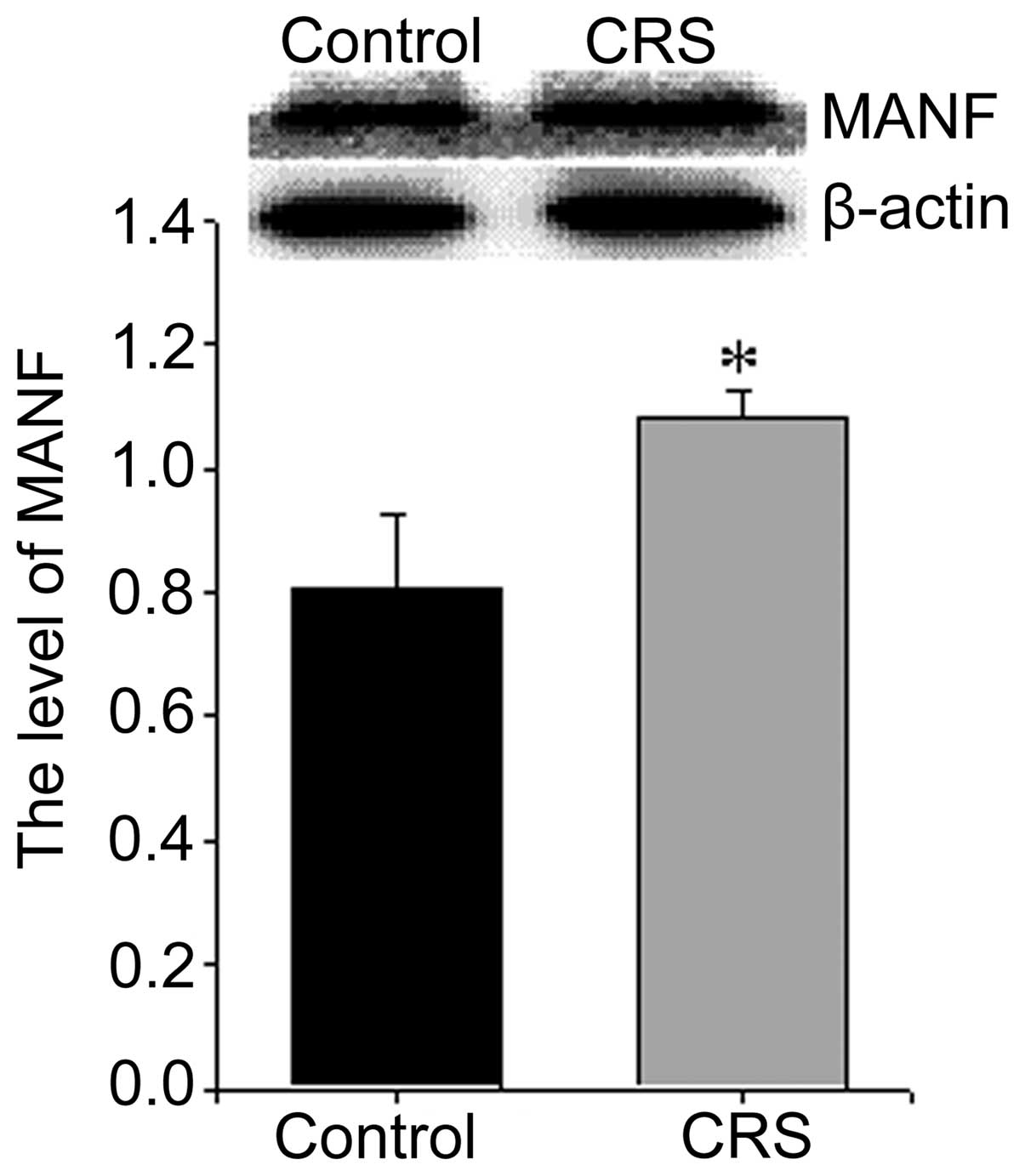|
1
|
Wilson RS, Evans DA, Bienias JL, Mendes de
Leon CF, Schneider JA and Bennett DA: Proneness to psychological
distress is associated with risk of Alzheimer’s disease. Neurology.
61:1479–1485. 2003. View Article : Google Scholar : PubMed/NCBI
|
|
2
|
Csernansky JG, Dong H, Fagan AM, et al:
Plasma cortisol and progression of dementia in subjects with
Alzheimer-type dementia. Am J Psychiatry. 163:2164–2169. 2006.
View Article : Google Scholar : PubMed/NCBI
|
|
3
|
Sandi C: Stress, cognitive impairment and
cell adhesion molecules. Nat Rev Neurosci. 5:917–930. 2004.
View Article : Google Scholar : PubMed/NCBI
|
|
4
|
McEwen BS and Magarinos AM: Stress and
hippocampal plasticity: implications for the pathophysiology of
affective disorders. Hum Psychopharmacol. 16:S7–S19. 2001.
View Article : Google Scholar
|
|
5
|
Kim JJ and Diamond DM: The stressed
hippocampus, synaptic plasticity and lost memories. Nat Rev
Neurosci. 3:453–462. 2002.PubMed/NCBI
|
|
6
|
Rothman SM and Mattson MP: Adverse stress,
hippocampal networks, and Alzheimer’s disease. Neuromolecular Med.
12:56–70. 2010. View Article : Google Scholar :
|
|
7
|
Li WZ, Li WP, Yao YY, et al:
Glucocorticoids increase impairments in learning and memory due to
elevated amyloid precursor protein expression and neuronal
apoptosis in 12-month old mice. Eur J Pharmacol. 628:108–115. 2010.
View Article : Google Scholar
|
|
8
|
Wang Y, Kan H, Yin Y, et al: Protective
effects of ginsenoside Rg1 on chronic restraint stress induced
learning and memory impairments in male mice. Pharmacol Biochem
Behav. 120:73–81. 2014. View Article : Google Scholar : PubMed/NCBI
|
|
9
|
Ansari N and Khodagholi F: Molecular
mechanism aspect of ER stress in Alzheimer’s disease: current
approaches and future strategies. Curr Drug Targets. 14:114–122.
2013. View Article : Google Scholar
|
|
10
|
Schroder M and Kaufman RJ: The mammalian
unfolded protein response. Annu Rev Biochem. 74:739–789. 2005.
View Article : Google Scholar : PubMed/NCBI
|
|
11
|
Lin JH, Li H, Yasumura D, et al: IRE1
signaling affects cell fate during the unfolded protein response.
Science. 318:944–949. 2007. View Article : Google Scholar : PubMed/NCBI
|
|
12
|
Minamino T and Kitakaze M: ER stress in
cardiovascular disease. J Mol Cell Cardiol. 48:1105–1110. 2010.
View Article : Google Scholar
|
|
13
|
Nakagawa T, Zhu H, Morishima N, et al:
Caspase-12 mediates endoplasmic-reticulum-specific apoptosis and
cytotoxicity by amyloid-beta. Nature. 403:98–103. 2000. View Article : Google Scholar : PubMed/NCBI
|
|
14
|
Marciniak SJ, Yun CY, Oyadomari S, et al:
CHOP induces death by promoting protein synthesis and oxidation in
the stressed endoplasmic reticulum. Genes Dev. 18:3066–3077. 2004.
View Article : Google Scholar : PubMed/NCBI
|
|
15
|
Katayama T, Imaizumi K, Manabe T, Hitomi
J, Kudo T and Tohyama M: Induction of neuronal death by ER stress
in Alzheimer’s disease. J Chem Neuroanat. 28:67–78. 2004.
View Article : Google Scholar : PubMed/NCBI
|
|
16
|
Costa RO, Ferreiro E, Martins I, et al:
Amyloid beta-induced ER stress is enhanced under mitochondrial
dysfunction conditions. Neurobiol Aging. 33:824.e5–824.e16. 2012.
View Article : Google Scholar
|
|
17
|
Moceri VM, Kukull WA, Emanuel I, van Belle
G and Larson EB: Early-life risk factors and the development of
Alzheimer’s disease. Neurology. 54:415–420. 2000. View Article : Google Scholar : PubMed/NCBI
|
|
18
|
Liu Y, Zhuang X, Gou L, et al: Protective
effects of nizofenone administration on the cognitive impairments
induced by chronic restraint stress in mice. Pharmacol Biochem
Behav. 103:474–480. 2013. View Article : Google Scholar
|
|
19
|
Yin D, Tuthill D, Mufson RA and Shi Y:
Chronic restraint stress promotes lymphocyte apoptosis by
modulating CD95 expression. J Exp Med. 191:1423–1428. 2000.
View Article : Google Scholar : PubMed/NCBI
|
|
20
|
Derin N, Yargicoglu P, Aslan M, Elmas O,
Agar A and Aiciguzel Y: The effect of sulfite and chronic restraint
stress on brain lipid peroxidation and anti-oxidant enzyme
activities. Toxicol Ind Health. 22:233–240. 2006. View Article : Google Scholar : PubMed/NCBI
|
|
21
|
Yin Y, Ren Y, Wu W, et al: Protective
effects of bilobalide on Aβ(25–35) induced learning and memory
impairments in male rats. Pharmacol Biochem Behav. 106:77–84. 2013.
View Article : Google Scholar : PubMed/NCBI
|
|
22
|
Vanitallie TB: Stress: a risk factor for
serious illness. Metabolism. 51:40–45. 2002. View Article : Google Scholar : PubMed/NCBI
|
|
23
|
Kaufman D, Banerji MA, Shorman I, et al:
Early-life stress and the development of obesity and insulin
resistance in juvenile bonnet macaques. Diabetes. 56:1382–1386.
2007. View Article : Google Scholar : PubMed/NCBI
|
|
24
|
Pittenger C and Duman RS: Stress,
depression, and neuroplasticity: a convergence of mechanisms.
Neuropsychopharmacology. 33:88–109. 2008. View Article : Google Scholar
|
|
25
|
Zafir A and Banu N: Modulation of in vivo
oxidative status by exogenous corticosterone and restraint stress
in rats. Stress. 12:167–177. 2009. View Article : Google Scholar
|
|
26
|
Jankord R and Herman JP: Limbic regulation
of hypothalamo-pituitary-adrenocortical function during acute and
chronic stress. Ann NY Acad Sci. 1148:64–73. 2008. View Article : Google Scholar
|
|
27
|
Ahmad A, Rasheed N, Ashraf GM, et al:
Brain region specific monoamine and oxidative changes during
restraint stress. Can J Neurol Sci. 39:311–318. 2012. View Article : Google Scholar : PubMed/NCBI
|
|
28
|
Kuo TC, Huang WJ and Guh JH: WJ9708012
exerts anticancer activity through PKC-α related crosstalk of
mitochondrial and endoplasmic reticulum stresses in human
hormone-refractory prostate cancer cells. Acta Pharmacol Sin.
32:89–98. 2011. View Article : Google Scholar
|
|
29
|
Wang XZ, Lawson B, Brewer JW, et al:
Signals from the stressed endoplasmic reticulum induce
C/EBP-homologous protein (CHOP/GADD153). Mol Cell Biol.
16:4273–4280. 1996.PubMed/NCBI
|
|
30
|
Groenendyk J and Michalak M: Endoplasmic
reticulum quality control and apoptosis. Acta Biochim Pol.
52:381–395. 2005.PubMed/NCBI
|
|
31
|
Watts LT, Rathinam ML, Schenker S and
Henderson GI: Astrocytes protect neurons from ethanol-induced
oxidative stress and apoptotic death. J Neurosci Res. 80:655–666.
2005. View Article : Google Scholar : PubMed/NCBI
|
|
32
|
Loh KP, Huang SH, De Silva R, Tan BK and
Zhu YZ: Oxidative stress: apoptosis in neuronal injury. Curr
Alzheimer Res. 3:327–337. 2006. View Article : Google Scholar : PubMed/NCBI
|
|
33
|
Wu M, Yang S, Elliott MH, et al: Oxidative
and endoplasmic reticulum stresses mediate apoptosis induced by
modified LDL in human retinal Müller cells. Invest Ophthalmol Vis
Sci. 53:4595–4604. 2012. View Article : Google Scholar : PubMed/NCBI
|
|
34
|
Xu C, Bailly-Maitre B and Reed JC:
Endoplasmic reticulum stress: cell life and death decisions. J Clin
Invest. 115:2656–2664. 2005. View
Article : Google Scholar : PubMed/NCBI
|
|
35
|
Park GB, Kim YS, Lee HK, et al:
Endoplasmic reticulum stress-mediated apoptosis of EBV-transformed
B cells by cross-linking of CD70 is dependent upon generation of
reactive oxygen species and activation of p38 MAPK and JNK pathway.
J Immunol. 185:7274–7284. 2010. View Article : Google Scholar : PubMed/NCBI
|
|
36
|
Pino SC, O'Sullivan-Murphy B, Lidstone EA,
et al: Protein kinase C signaling during T cell activation induces
the endoplasmic reticulum stress response. Cell Stress Chaperones.
13:421–434. 2008. View Article : Google Scholar : PubMed/NCBI
|
|
37
|
Lien YC, Kung HN, Lu KS, Jeng CJ and Chau
YP: Involvement of endoplasmic reticulum stress and activation of
MAP kinases in beta-lapachone-induced human prostate cancer cell
apoptosis. Histol Histopathol. 23:1299–1308. 2008.PubMed/NCBI
|
|
38
|
Mauro A, Ciccarelli C, De Cesaris P, et
al: PKCα-mediated ERK, JNK and p38 activation regulates the
myogenic program in human rhabdomyosarcoma cells. J Cell Sci.
115:3587–3599. 2002. View Article : Google Scholar : PubMed/NCBI
|
|
39
|
Song MS, Park YK, Lee JH and Park K:
Induction of glucose-regulated protein 78 by chronic hypoxia in
human gastric tumor cells through a protein kinase
C-epsilon/ERK/AP-1 signaling cascade. Cancer Res. 61:8322–8330.
2001.PubMed/NCBI
|
|
40
|
Liu H, Bowes RC III, van de Water B,
Sillence C, Nagelkerke JF and Stevens JL: Endoplasmic reticulum
chaperones GRP78 and calreticulin prevent oxidative stress,
Ca2+ disturbances, and cell death in renal epithelial
cells. J Biol Chem. 272:21751–21759. 1997. View Article : Google Scholar : PubMed/NCBI
|
|
41
|
Yu Z, Luo H, Fu W and Mattson MP: The
endoplasmic reticulum stress-responsive protein GRP78 protects
neurons against excitotoxicity and apoptosis: suppression of
oxidative stress and stabilization of calcium homeostasis. Exp
Neurol. 155:302–314. 1999. View Article : Google Scholar : PubMed/NCBI
|
|
42
|
Yin QQ, Dong CF, Dong SQ, et al: AGEs
induce cell death via oxidative and endoplasmic reticulum stresses
in both human SH-SY5Y neuroblastoma cells and rat cortical neurons.
Cell Mol Neurobiol. 32:1299–1309. 2012. View Article : Google Scholar : PubMed/NCBI
|
|
43
|
Szegezdi E, Logue SE, Gorman AM and Samali
A: Mediators of endoplasmic reticulum stress-induced apoptosis.
EMBO Rep. 7:880–885. 2006. View Article : Google Scholar : PubMed/NCBI
|
|
44
|
Oyadomari S and Mori M: Roles of
CHOP/GADD153 in endoplasmic reticulum stress. Cell Death Differ.
11:381–389. 2004. View Article : Google Scholar
|
|
45
|
Tajiri S, Oyadomari S, Yano S, et al:
Ischemia-induced neuronal cell death is mediated by the endoplasmic
reticulum stress pathway involving CHOP. Cell Death Differ.
11:403–415. 2004. View Article : Google Scholar : PubMed/NCBI
|
|
46
|
Parkash V, Lindholm P, Peranen J, et al:
The structure of the conserved neurotrophic factors MANF and CDNF
explains why they are bifunctional. Protein Eng Des Sel.
22:233–241. 2009. View Article : Google Scholar : PubMed/NCBI
|
|
47
|
Hayashi T, Saito A, Okuno S, Ferrand-Drake
M, Dodd RL and Chan PH: Oxidative injury to the endoplasmic
reticulum in mouse brains after transient focal ischemia. Neurobiol
Dis. 15:229–239. 2004. View Article : Google Scholar : PubMed/NCBI
|
|
48
|
Rabek JP, Boylston WH III and
Papaconstantinou J: Carbonylation of ER chaperone proteins in aged
mouse liver. Biochem Biophys Res Commun. 305:566–572. 2003.
View Article : Google Scholar : PubMed/NCBI
|



